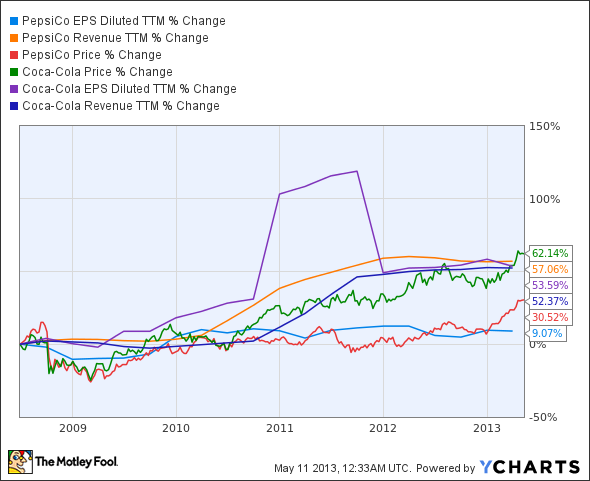If you thought a key ingredient used by The Coca-Cola Company (NYSE:KO) was obtained only from the coca plant, you may have been barking up the wrong tree.
Juiced up
The Atlanta-based company is working out details with growers in Florida and Brazil to purchase oranges from them. Yes, oranges. It will spend about $2 billion in Florida alone over the next 20 years.

The growth spurt might be coming at a good time. Sales of the company’s best known brand, Coke, and other cola-flavored soft drinks might be affected in the long run, not by general economic trends, but by increasing pressure from consumer watch groups, health advocates and politicians like NYC Mayor Michael Bloomberg as part of an effort to reduce obesity rates.
In a controversial move Mr. Bloomberg recently banned “sugary” soft drinks larger than 16 oz. from the Big Apple. The size limitation was later overturned by a judge.
The Coca-Cola Company (NYSE:KO) is not alone. The biggest buyer of Florida oranges is Tropicana, owned by their archrival PepsiCo, Inc (NYSE:PEP). Pepsi has deals in place with 12 different growers in the Sunshine State. In order to have a supply available year-round, it also buys from Brazil.
While Tropicana is still the number-one seller in the segment, it has been losing share. It now has 20% of the market, down from a peak of 22% in 2009. The Minute Maid brands have about a 14% share, up two percentage points over the same period.
According to many analysts, Pepsi seems to be paying less attention to its beverage business in order to grow its snack food segment. Has the strategy worked? Revenue, earnings, and the stock price are all up over the last five years. However, Pepsi’s performance has lagged that of The Coca-Cola Company (NYSE:KO), which has had gains of over 50% in each category over the same time period.
Monster juice
Another company that uses oranges in its juice drinks is Monster Beverage Corp (NASDAQ:MNST). There have been no reports of the company making any deals with growers in Florida or Brazil to increase the supply, however.
Monster Beverage Corp (NASDAQ:MNST), known for its “energy” drinks and decorated cans, is a relatively new company, having started operations under its current name in 2007. It has about a century to go to catch up to both The Coca-Cola Company (NYSE:KO) and PepsiCo, Inc (NYSE:PEP).
Another area where Monster needs to catch up to its rivals is in growth. While earnings and revenue have increased at a fairly robust rate over the last several years it still lags its competitors for the most part.
And Monster stock is lagging behind Coca-Cola and PepsiCo too. The price has declined about 25% since peaking in July 2012. Investors may be betting that the growth will not continue. With a current P/E of about 31 the stock’s value is significantly above its peers in the industry. Unlike Coca-Cola and PepsiCo, Monster does not offer a dividend but it does have a cleaner balance sheet with no long term debt on the books.
Conclusion
So the most popular color in a Coca-Cola drink in the future might be orange. It appears that the company is gearing up for that possibility by having more citrus planted in Florida. That will surely help the bottom line (and maybe some waistlines too).
The article Orange Growth for Coca-Cola originally appeared on Fool.com and is written by Mark Morelli.
Copyright © 1995 – 2013 The Motley Fool, LLC. All rights reserved. The Motley Fool has a disclosure policy.



